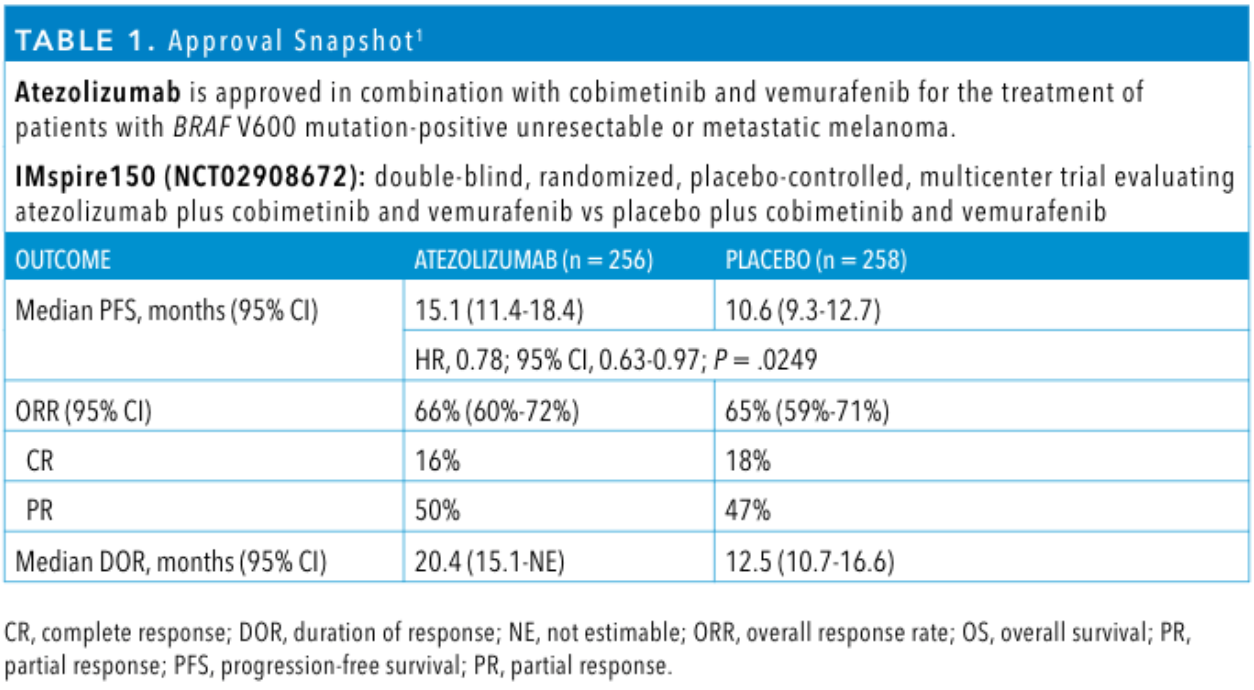Article
Finding the Optimal Therapeutic Sequence for Advanced Hepatocellular Carcinoma
Author(s):
Several breakthroughs in recent years have rapidly shifted the treatment landscape for advanced HCC.
Timothy J. Brown, MD

For nearly a decade after the SHARP trial (NCT00105443) had established sorafenib (Nexavar) as the standard of care for advanced hepatocellular carcinoma (HCC), progress in the development of systemic therapies for advanced HCC was frustratingly slow, with many clinical trials failing to improve outcomes vs sorafenib or placebo.1 Fortunately, several breakthroughs in recent years have rapidly shifted the treatment landscape for advanced HCC.
Since 2017, 9 drugs have received an FDA approval for HCC. Most importantly, an improved frontline regimen for advanced HCC has been solidly established with the publication of results from the IMbrave150 trial (NCT03434379).2 For patients with preserved liver function and no active esophageal varices, the combination of the PD-L1 inhibitor atezolizumab (Tecentriq) and the VEGF inhibitor bevacizumab (Avastin) is the current frontline standard on the basis of improved overall survival (OS), progression-free survival (PFS), objective response rate, and toxicity pro-file compared with sorafenib.2
Although atezolizumab and bevacizumab is the standard initial therapy for eligible patients with advanced HCC, results from a number of phase 3 trials evaluating immunotherapy combinations in the frontline setting are expected to be published in the near future. These include COSMIC-312 (NCT03755791), LEAP-002 (NCT03713593), HIMALAYA (NCT03298451), CheckMate 9DW (NCT04039607), and RATIONALE-301 (NCT03412773), among others.3 Recently it was announced that the HIMALAYA trial, in which investigators are evaluating tremelimumab and durvalumab (Imfinzi) vs sorafenib in first-line untreated HCC, had met its primary end point of improved OS. COSMIC 312, which is examining the efficacy of cabozantinib (Cabometyx) and atezolizumab vs sorafenib, is not expected to improve OS vs sorafenib based on an interim analysis.4,5
If findings from multiple frontline trials are positive, it may prove difficult to choose between frontline immunotherapy combination regimens based solely on cross-trial comparisons. For now, atezolizumab and bevacizumab is clearly the best available frontline option for systemic therapy for eligible patients.
Thomas B. Karasic, MD

Addressing an Unmet Need in HCC
Despite the unprecedented improvements in OS and PFS observed with atezolizumab and bevacizumab, many patients will invariably experience progressive disease. For those patients, no definitive prospective data are available to guide decisions regarding subsequent treatments. Given the timelines required for the design and execution of clinical trials, such data may not be available for years.
Standard clinical practice is to evaluate those who are still eligible for systemic therapy for clinical trial enrollment at the time of progression. However, without an available clinical trial, the approach to therapy following progression on atezolizumab and bevacizumab is up for debate and guided mostly by expert opinion extrapolated from prior experience. The American Society of Clinical Oncology (ASCO) issued formal guidelines in 2020 recommending second-line therapy individualized to patient and clinician factors, with the caveat that data for second-line therapy in clinical trials were appropriate only following progression with sorafenib (Table6).
As there is a lack of high-quality data to guide practice in the second-line setting after atezolizumab and bevacizumab, cur-rent treatment paradigms for second-line systemic therapy include shifting all previously approved and available first-line therapies, such as sorafenib and lenvatinib (Lenvima), to the second line or simply forgoing prior first-line therapies and moving forward with previously approved second- and third-line ones (eg, cabozantinib and regorafenib [Stivarga]).
First-line tyrosine kinase inhibitors (TKIs) exert their anticancer activity pri-marily through VEGF inhibition. Second-line TKIs target additional established VEGF-resistance pathways—MET for cabozantinib, TIE2 for regorafenib—and have proven efficacy after prior anti-VEGF therapy with sorafenib.7,8 Conversely, over the course of a decade of investigators’ evaluating other VEGF TKIs vs sorafenib in trials, only lenvatinib produced a positive result, supporting the current place of sorafenib and lenvatinib as the initial TKIs regardless of prior therapy. It is unlikely that clinical trials will be designed to empirically address the optimal sequencing of TKIs. Further, bias by indication will con-found all retrospective analyses that will emerge attempting to answer this question.

Reevaluating the Continued Role of Standard Care
Early retrospective data suggest that multikinase inhibitors such as sorafenib and lenvatinib retain activity after a patient has progressed on atezolizumab and bevacizumab.9 For example, in results from a multicenter retrospective analysis of Asian patients, partial responses were only seen with lenvatinib, most patients on sorafenib having stable disease. In this study, median OS from the date of initiation of second-line therapy with TKIs following progression on atezolizumab and bevacizumab was 14.7 months and median PFS was 3.4 months. The overall response rate was 6.1% among the 49 treated patients.
Although these data are limited by the study design, they do provide preliminary reassurance that TKIs retain relevant activity after atezolizumab and bevacizumab.9 For patients experiencing progressive disease who are not enrolling in clinical trials, our practice has been to initiate second-line therapy with lenvatinib given the improved PFS and decreased rates of important toxicities including diarrhea and hand-foot syndrome when compared with sorafenib.10
Recognizing the shortcomings in the available data, the ASCO guideline committee only issued an informal consensus recommendation for second-line therapy with a TKI such as sorafenib and lenvatinib, but also noted that cabozantinib and regorafenib may be offered.6 Ramucirumab (Cyramza) is also an option for patients with an α-fetoprotein level of 400 ng/mL or higher, but there is concern that the drug may not retain as much activity as a TKI after progression on bevacizumab given the highly similar mechanisms of action of ramucirumab and bevacizumab.11 The evidence quality for these recommendations was weak and the strength of the resulting recommendation was low.
Alternative Options
The role of subsequent immunotherapy following progression on atezolizumab and bevacizumab remains unsettled. The combination of nivolumab and ipilimumab (Yervoy) was approved after sorafenib based on prolonged survival in a phase 2 cohort of the CheckMate040 study (NCT01658878), but not all patients in the study had received prior immunotherapy.12
In melanoma, a response rate of 13% was reported among 97 patients who received ipilimumab alone after prior PD-1 blockade in results of the KEYNOTE-006 trial (NCT01866319), similar to the response rate of 29% among 70 immunotherapy-naïve patients who received ipilimumab and pembrolizumab together in a phase 2 trial (NCT02743819).13 A response rate of 58% was seen with dual checkpoint blockade in immunotherapy-naïve patients.13
Whether similar retreatment efficacy with immunotherapy holds in HCC remains unknown, but with response rates of only 7% with tremelimumab monotherapy and 30% with nivolumab and ipilimumab in immunotherapy-naïve patients, the response rate is likely to be low following rechallenge with dual checkpoint blockade after atezolizumab and bevacizumab. More-over, toxicity can be significant.12,14 For these reasons, we favor second-line TKI therapy in eligible patients, with immunotherapy rechallenge reserved for the third- or later-line setting.
Furthermore, a more prolonged and deeper initial response to frontline atezolizumab and bevacizumab is more suggestive of immune activation than VEGF response; we primarily con-sider immunotherapy rechallenge in those who experienced an objective response to atezolizumab and bevacizumab or experienced disease stability for at least 6 months.
Another important question that remains is how to approach patients with advanced HCC who are not eligible for atezolizumab or bevacizumab. Contraindications to this regimen include severe active autoimmune disease, solid organ or allogeneic stem cell transplant, recent myocardial infarction or stroke, active and untreated esophageal varices, uncontrolled hypertension, nonhealing wounds, and congestive heart failure.2 For patients with contraindications to anti-angiogenic therapy, the use of the TKIs sorafenib and lenvatinib would also be contraindicated.
National Comprehensive Cancer Network guidelines support the use of nivolumab in this setting based on findings from CheckMate 459 (NCT02576509).15 Some patients may also prefer to avoid intravenous therapies and opt for oral agents, especially during the COVID-19 pandemic. Options for these patients include the previous standard frontline TKIs sorafenib or lenvatinib.6 Lenvatinib is our preferred option for those with preserved liver function (Child-Pugh A) on the basis of data from the REFLECT trial (NCT01761266), which showed improved PFS and overall response rates.10 There are also some tradeoffs with adverse effects; lenvatinib is associated with increased fatigue, hypertension, proteinuria, and anorexia, but less diarrhea and hand-foot syndrome compared with sorafenib.10
Uncovering Paths Forward For Poor Liver Function
Finally, there remains a paucity of data on the treatment of patients with Child-Pugh B liver function. These patients are typically excluded or are underrepresented in clinical trials for advanced HCC, yet they represent a significant proportion of the patients seen in routine clinical practice.2,6 Notably, these patients were not included in IMbrave150 because of concerns about the bleeding risk associated with bevacizumab.2
Prospective phase 2 cohorts have demonstrated safety and efficacy of both nivolumab and sorafenib in patients with Child-Pugh B cirrhosis.12,16 The ASCO guidelines specifically do not offer recommendations for this group of patients, instead advising a multidisciplinary discussion for their treatment and a cautious approach to systemic therapy.6 More recently, retrospective data from the Veterans Affairs showed improved OS with nivolumab compared to sorafenib in Child-Pugh B cirrhosis, although prospective comparative data in patients with Child-Pugh B cirrhosis is sorely lacking.17 Our practice is to offer these patients nivolumab initially and consider sorafenib at progression if liver function permits.
In conclusion, combination atezolizumab and bevacizumab is the current standard for frontline treatment for eligible patients with advanced HCC, although additional frontline immunotherapy combinations will likely become available within the next year. For patients who progress after initial atezolizumab and bevacizumab, no defined treatment paradigm yet exists, although TKIs are used most often. The utility of immunotherapy rechallenge remains uncertain.
Over the next 1 to 2 years as additional front-line immunotherapy combinations emerge, the development of consensus guidelines will be critical to guide practicing oncologists through the expanding array of treatment options, a fortunate problem few might have predicted just a few short years ago.
Timothy J. Brown, MD, is a chief fellow in the Division of Hematology and Oncology at Abramson Cancer Center and the University ofPennsylvania in Philadelphia.
Thomas B. Karasic, MD, is an assistant professor of medicine at Perelman School of Medicine at the University of Pennsylvania in Philadelphia.
References
- Llovet JM, Ricci S, Mazzaferro V, et al; SHARP Investigators Study Group. Sorafenib in advanced hepatocellular carcinoma. N Engl J Med. 2008;359(4):378-390. doi:10.1056/NEJMoa0708857
- Finn RS, Qin S, Ikeda M, et al; IMbrave150 Investigators. Atezolizumab plus bevaci-zumab in unresectable hepatocellular carcinoma. N Engl J Med. 2020;382(20):1894-1905. doi:10.1056/NEJMoa1915745
- Sangro B, Sarobe P, Hervás-Stubbs S, Melero I. Advances in immunotherapy for hepatocellular carcinoma. Nat Rev Gastroenterol Hepatol. 2021;18(8):525-543. doi:10.1038/s41575-021-00438-0
- Exelixis and Ipsen announce cabozantinib in combination with an immune checkpoint inhibitor significantly improved progression-free survival in phase 3 COSMIC-312 pivotal trial in patients with previously untreated advanced liver cancer. News release. Ipsen. June 28, 2021. Accessed October 29, 2021. https://www.ipsen.com/websites/Ipsen_Online/wp-content/uploads/2021/06/09120111/Ipsen-Exelixis-COSMIC-312-28-June-2021.pdf
- IMFINZI plus tremelimumab significantly improved overall survival in HIMALAYA phase III trial in 1st-line unresectable liver cancer. News release. AstraZeneca. Octo-ber 15, 2021. Accessed October 29, 2021. https://www.astrazeneca-us.com/content/az-us/media/press-releases/2021/imfinzi-plus-tremelimumab-significantly-im-proved-overall-survival-in-himalaya-phase-iii-trial-in-1st-line-unresectable-liver-can-cer-10152021.html
- Gordan JD, Kennedy EB, Abou-Alfa GK, et al. Systemic therapy for advanced he-patocellular carcinoma: ASCO guideline. J Clin Oncol. 2020;38(36):4317-4345. doi:10.1200/JCO.20.02672
- Abou-Alfa GK, Meyer T, Cheng AL, et al. Cabozantinib in patients with advanced and progressing hepatocellular carcinoma. N Engl J Med. 2018;379(1):54-63. doi:10.1056/NEJMoa1717002
- Bruix J, Qin S, Merle P, et al; RESORCE Investigators. Regorafenib for pa-tients with hepatocellular carcinoma who progressed on sorafenib treatment (RE-SORCE): a randomised, double-blind, placebo-controlled, phase 3 trial. Lancet. 2017;389(10064):56-66. doi:10.1016/S0140-6736(16)32453-9
- Yoo C, Kim JH, Ryu MH, et al. Clinical outcomes with multikinase inhibitors after progression on first-line atezolizumab plus bevacizumab in patients with advanced hepatocellular carcinoma: a multinational multicenter retrospective study. Liver Can-cer. 2021;10(2):107-114. doi:10.1159/000512781
- Kudo M, Finn RS, Qin S, et al. Lenvatinib versus sorafenib in first-line treatment of patients with unresectable hepatocellular carcinoma: a randomised phase 3 non-inferiority trial. Lancet. 2018;391(10126):1163-1173. doi:10.1016/S0140-6736(18)30207-1
- Zhu AX, Kang YK, Yen CJ, et al; REACH-2 study investigators. Ramucirumab af-ter sorafenib in patients with advanced hepatocellular carcinoma and increased α-fetoprotein concentrations (REACH-2): a randomised, double-blind, placebo-con-trolled, phase 3 trial. Lancet Oncol. 2019;20(2):282-296. doi:10.1016/S1470-2045(18)30937-9
- Yau T, Kang YK, Kim TY, et al. Efficacy and safety of nivolumab plus ipilimumab in patients with advanced hepatocellular carcinoma previously treated with sorafenib: the CheckMate 040 randomized clinical trial. JAMA Oncol. 2020;6(11):e204564. doi:10.1001/jamaoncol.2020.4564
- Olson DJ, Eroglu Z, Brockstein B, et al. Pembrolizumab plus ipilimumab fol-lowing anti-PD-1/L1 failure in melanoma. J Clin Oncol. 2021;39(24):2647-2655. doi:10.1200/JCO.21.00079
- Kelley RK, Sangro B, Harris W, et al. Safety, efficacy, and pharmacodynamics of tremelimumab plus durvalumab for patients with unresectable hepatocellular carci-noma: randomized expansion of a phase I/II study. J Clin Oncol. 2021;39(27):2991-3001. doi:10.1200/JCO.20.03555
- Sangro B, Park J, Finn RS, et al. CheckMate 459: long-term (minimum follow-up 33.6 months) survival outcomes with nivolumab versus sorafenib as first-line treat-ment in patients with advanced hepatocellular carcinoma. Ann Oncol. 2020;31(suppl 3):S241-S242. doi:10.1016/j.annonc.2020.04.078
- Abou-Alfa GK, Amadori D, Santoro A, et al. Safety and efficacy of sorafenib in pa-tients with hepatocellular carcinoma (HCC) and Child-Pugh A versus B cirrhosis. Gastrointest Cancer Res. 2011;4(2):40-44.
- Chapin WJ, Hwang WT, Karasic TB, McCarthy AM, Kaplan DE. Comparative effec-tiveness of sorafenib, lenvatinib, and nivolumab as first-line systemic therapy for patients with advanced hepatocellular carcinoma and Child-Pugh class B cirrhosis treated at VA Medical Centers. J Clin Oncol. 2021;39(suppl 15):4102. doi:10.1200/JCO.2021.29.15_suppl.4102









